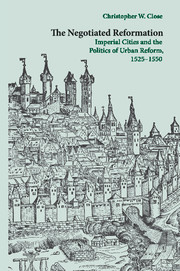Book contents
- Frontmatter
- Contents
- List of Abbreviations
- Acknowledgments
- Map One South German Imperial Cities ca. 1525
- Map Two Imperial Cities in Upper and Eastern Swabia
- Introduction
- 1 Consultation and the Urban Hierarchy
- 2 Imperial Cities and Collective Politics
- 3 Preachers, Consultation, and the Spread of Urban Reform in Southern Germany
- 4 The Urban Reformation in Donauwörth
- 5 The Urban Reformation in Kaufbeuren
- 6 Negotiation and the Rural Reformation in Eastern Swabia
- 7 Eastern Swabia and the Schmalkaldic War
- Conclusion
- Bibliography
- Index
- References
Introduction
Published online by Cambridge University Press: 26 December 2009
- Frontmatter
- Contents
- List of Abbreviations
- Acknowledgments
- Map One South German Imperial Cities ca. 1525
- Map Two Imperial Cities in Upper and Eastern Swabia
- Introduction
- 1 Consultation and the Urban Hierarchy
- 2 Imperial Cities and Collective Politics
- 3 Preachers, Consultation, and the Spread of Urban Reform in Southern Germany
- 4 The Urban Reformation in Donauwörth
- 5 The Urban Reformation in Kaufbeuren
- 6 Negotiation and the Rural Reformation in Eastern Swabia
- 7 Eastern Swabia and the Schmalkaldic War
- Conclusion
- Bibliography
- Index
- References
Summary
In early July 1546, war erupted in the Holy Roman Empire. On one side stood the Emperor Charles V, a supporter of the Catholic Church who sought to quell the religious dissension introduced into his realm by the Reformation. Opposing the emperor was an alliance of Protestant estates known as the Schmalkaldic League. Led by the prince-elector of Saxony and the landgrave of Hesse, two of the Empire's most powerful noblemen, the Schmalkaldic League's membership stretched across the geographic breadth of the Empire. Its financial base rested largely on mercantile wealth from its urban members in the south, self-governing republics called imperial cities. Autonomous city-states ruled by elected councils, imperial cities owed allegiance to no territorial lord but the emperor. During the 1520s and 1530s, many of these cities introduced evangelical religious reform within their walls. This severed their ties to the Catholic Church and placed a growing strain on their relationship with the emperor. Fearing imperial retribution for their religious deviance, many evangelical imperial cities joined the Schmalkaldic League, which promised military protection to its members. As armed conflict began in the summer of 1546, imperial cities across southern Germany mobilized their armies in defense of the Reformation.
Two exceptions to this mobilization were the Eastern Swabian imperial cities Donauwörth and Kaufbeuren. Located just to the north and south of Augsburg, Swabia's largest and in many ways most influential city, Donauwörth and Kaufbeuren first adopted evangelical reform in 1545.
- Type
- Chapter
- Information
- The Negotiated ReformationImperial Cities and the Politics of Urban Reform, 1525–1550, pp. 1 - 19Publisher: Cambridge University PressPrint publication year: 2009



